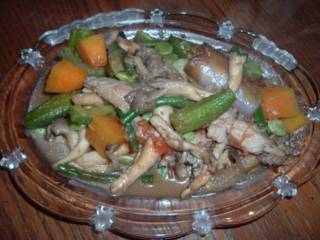I posted a pinakbet here quite a while ago which was more like a tagalog version. Manong Mannurat gave me a description of the real Iloko Pinakbet which I am copying for everyone to know. Here it is in his own words.
“of course, pinakbet or pakbet originated from ilocos. the name itself clearly prove it. "pinakbet" is an iloko word. it's actually a contracted "pinakebbet" meaning shrinked or shrivelled.the original ilokano pinakbet use only the bugguong which is monamon or other fish. but not bagoong alamang or aramang. also, the original pinakbet has no squash in it. usually its most basic veggies are only ampalaya (the round native ones are preferred), talong, kamatis, ginger (okra and/or sili is optional as are the other veggies). and as its name denote, it is actually cooked almost dry, shrivelled, shrinked”
I can imagine Manong shaking his head and and saying “haan nga dayta ti usto nga pinakbet iloko” (that’s not the right Iloko Pinakbet) but allow me Manong to modify your most favorite Ilokano dish so that this will be appealing to my children. My mother’s origins are from Ilocos Norte but I grew up in Baguio City. Anyway, the kalabasa and the patani is something I inherited from my friend’s mother who is from Dingras. The mushroom was something I got from a friend from Isabela.
Ingredients:
2 tbsp of olive oil
About ½ lb of lean pork
1 onion, coarsely chopped
1 tomato coarsely chopped
about 10 tbsp of “bugguong” bagoong monamon sauce
2 eggplants, sliced in three and each slice cut further in quarters
½ amplaya
about 6 pcs of ocra
about 2 long sili
about 15 pcs of long green beans cut in about 1 ½ inches long
½ small kalabasa
about ¼ cup of patani
and about 100 gms of oyster myshrooms
In a separate pan, heat the oil, add the pork, sauté the onion and the tomatoes. Set aside.
Put all the vegetables in a deep saucepan. Add the sautéed meat, tomato and onion. Add the bagoong and about ½ cup of water. Cover pan and let boil. Simmer for about 8-10 minutes. Adjust seasoning accordinag to your taste. Serve hot.
There you go Manong. I will cook dinengdeng soon but I'm afraid there will be another modification.

10 comments:
Ting-Aling, mmmm...sarap naman. I don't know why but I always remember Pinakbet as having a distinct smell. Ginugutom tuloy ako :-) Have a good weekend!
eto ang tunay, not like mine (imbento). I prefer the monamon too, more tasty. My Ma's "cousins" while fr. Pangasinan, all moved to Trinidad, just outside Baguio and these are the types of dishes they served whenever we visited. Thanks Ting-aling, this will be my next pinakbet try (mali ba ang "pakbet"?).
This is how my lola makes pinakbet, just like the way Mannurat describes it, similar to dinengdeng.
OO nga Sari ano? It's the aroma.
Drstel..sabi nga ni Mr. Mannurat, it's not just Ilokano anymore..kung baga sa English.."never mind the pronansyon as long as you get da idia". Different folks, different strokes. You know what? my husband's family is from Pangasinan but some of them moved to La Trinidad..haha baka magkamag-anak sila. Me and my husband grew up in Baguio..we were born there. Some call it Pakbet but I think Pinakbet is more common..
Jmom, I think, the difference lies in the manner of cooking and the amount of water you add in, di ba?
agyamanak, ading ting-aling, for the special mention!
as i've said pinakbet has became a national, a truly filipino dish because of the many versions or variations made by other ethnic or regional groups in the philippines. not anymore strictly ilokano. although, as manong ken quoted, the pinakbet of the true ilokano is different. depende na kasi 'yan sa "regional" taste o preference (like using bagoong alamang instead of monamon, or the preference/liking of the ilokanos of bitter foodstuffs).
of course, as an ilokano, when i cook pinakbet i'll do it the way the ilokanos do or prefer. but now, i'm also used to "other" pinakbets as well, and equally like them.
anyway, about inabraw, you might want to try this one from an ilokano in la union.
agyamanak, ading ting-aling, for the special mention!
as i've said pinakbet has became a national, a truly filipino dish because of the many versions or variations made by other ethnic or regional groups in the philippines. not anymore strictly ilokano. although, as manong ken quoted, the pinakbet of the true ilokano is different. depende na kasi 'yan sa "regional" taste o preference (like using bagoong alamang instead of monamon, or the preference/liking of the ilokanos of bitter foodstuffs).
of course, as an ilokano, when i cook pinakbet i'll do it the way the ilokanos do or prefer. but now, i'm also used to "other" pinakbets as well, and equally like them.
anyway, about inabraw, you might want to try this one from an ilokano in la union.
sorry for the double post...
i saved the recipe in my harddisk and also printed it. i'll try this. i also love patani and uong. i used to dengdeng fresh patani and sagpaw it with ampalaya (bunga) and dried kurus (small shrimps). same with uong (straw mushrooms, or any mushroom), i abraw it with ampalaya shoots/leaves or bunga, or even sagpaw it with sili leaves.
rva
mannurat.blogspot.com
Pinakbet using bagoong alamang is not pinakbet at all. It's called bulanglang. I always correct my Tagalog and Kapampangan cousins whenever they try calling my bulanglang a pinakbet. And pinakbet calls for bagoong isda and no squash at all.
Post a Comment